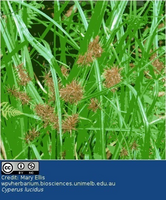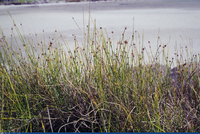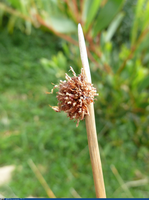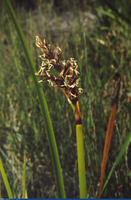Plant Group: Monocotyledon
Family Description:
Perennial herbs growing in damp places; stems usually solid; leaves long and narrow often reduced to sheaths; flowers arising in axil of glume arranged in spikelets.
| Genera | Species | Images |
|---|---|---|
|
Baumea Twig-rushes are slender, rush-like, rhizomatous perennial sedges. Leaves and flowering stems are similar in shape and size. The flowerhead is a terminal panicle. |
tetragona | |
|
Baumea Twig-rushes are slender, rush-like, rhizomatous perennial sedges. Leaves and flowering stems are similar in shape and size. The flowerhead is a terminal panicle. |
juncea | |
|
Carex Perennial, grass-like sedges forming tufts to 1m, often with rhizomes. Flowers are unisexual in plume-like terminal spikes. |
pumila | |
|
Cladium |
procerum | |
|
Cyperus Sedges with creeping rhizomes. Leaves long and grass-like at the base of triangular flowering stems. Flowers are terminal umbels. |
lucidus |

|
|
Ficinia |
nodosa |


|
|
Gahnia Saw-sedges have strap-shaped leaves sheathing round the stem and spirally arranged, tapering to a fine point. Leaf margins have very sharp bristles, the edges are like a saw. Flowers are cream in dark brown to black panicles. Fruit are hard nuts. |
clarkei |

|
|
Gahnia Saw-sedges have strap-shaped leaves sheathing round the stem and spirally arranged, tapering to a fine point. Leaf margins have very sharp bristles, the edges are like a saw. Flowers are cream in dark brown to black panicles. Fruit are hard nuts. |
filum | |
|
Gahnia Saw-sedges have strap-shaped leaves sheathing round the stem and spirally arranged, tapering to a fine point. Leaf margins have very sharp bristles, the edges are like a saw. Flowers are cream in dark brown to black panicles. Fruit are hard nuts. |
radula | |
|
Gahnia Saw-sedges have strap-shaped leaves sheathing round the stem and spirally arranged, tapering to a fine point. Leaf margins have very sharp bristles, the edges are like a saw. Flowers are cream in dark brown to black panicles. Fruit are hard nuts. |
trifida | |
|
Gymnoschoenus |
sphaerocephalus | |
|
Isolepis Club-rushes are rhizomatous, tufted, single-stemmed sedges, usually found in damp swampy ground. Leaves are basal and small or reduced to sheaths on the nodeless stem. The brownish-yellow flowers are borne in a dense terminal head of 1 to many spikelets, a stiff erect terminal bract continuing the stem. Fruit are nuts. |
marginata | |
|
Isolepis Club-rushes are rhizomatous, tufted, single-stemmed sedges, usually found in damp swampy ground. Leaves are basal and small or reduced to sheaths on the nodeless stem. The brownish-yellow flowers are borne in a dense terminal head of 1 to many spikelets, a stiff erect terminal bract continuing the stem. Fruit are nuts. |
inundata | |
|
Isolepis Club-rushes are rhizomatous, tufted, single-stemmed sedges, usually found in damp swampy ground. Leaves are basal and small or reduced to sheaths on the nodeless stem. The brownish-yellow flowers are borne in a dense terminal head of 1 to many spikelets, a stiff erect terminal bract continuing the stem. Fruit are nuts. |
cernua | |
|
Lepidosperma Sword-sedges are perennial sedges occurring in heaths and moist sites. Plants are tufted, spreading by creeping rhizomes. The erect stems and leaves are very similar in appearance and length, with all leaves basal and sometimes flatter than stems. Flowers are terminal panicles with the lowest bract sheathing the base of the panicle. The fruit is a nut, surrounded by 6 thickened whitish scales. The sword or rapier-shape of the leaves is the distinguishing characteristic. |
filiforme | |
|
Lepidosperma Sword-sedges are perennial sedges occurring in heaths and moist sites. Plants are tufted, spreading by creeping rhizomes. The erect stems and leaves are very similar in appearance and length, with all leaves basal and sometimes flatter than stems. Flowers are terminal panicles with the lowest bract sheathing the base of the panicle. The fruit is a nut, surrounded by 6 thickened whitish scales. The sword or rapier-shape of the leaves is the distinguishing characteristic. |
forsythii | |
|
Lepidosperma Sword-sedges are perennial sedges occurring in heaths and moist sites. Plants are tufted, spreading by creeping rhizomes. The erect stems and leaves are very similar in appearance and length, with all leaves basal and sometimes flatter than stems. Flowers are terminal panicles with the lowest bract sheathing the base of the panicle. The fruit is a nut, surrounded by 6 thickened whitish scales. The sword or rapier-shape of the leaves is the distinguishing characteristic. |
gladiatum | |
|
Lepidosperma Sword-sedges are perennial sedges occurring in heaths and moist sites. Plants are tufted, spreading by creeping rhizomes. The erect stems and leaves are very similar in appearance and length, with all leaves basal and sometimes flatter than stems. Flowers are terminal panicles with the lowest bract sheathing the base of the panicle. The fruit is a nut, surrounded by 6 thickened whitish scales. The sword or rapier-shape of the leaves is the distinguishing characteristic. |
laterale | |
|
Lepidosperma Sword-sedges are perennial sedges occurring in heaths and moist sites. Plants are tufted, spreading by creeping rhizomes. The erect stems and leaves are very similar in appearance and length, with all leaves basal and sometimes flatter than stems. Flowers are terminal panicles with the lowest bract sheathing the base of the panicle. The fruit is a nut, surrounded by 6 thickened whitish scales. The sword or rapier-shape of the leaves is the distinguishing characteristic. |
longitudinale | |
|
Lepidosperma Sword-sedges are perennial sedges occurring in heaths and moist sites. Plants are tufted, spreading by creeping rhizomes. The erect stems and leaves are very similar in appearance and length, with all leaves basal and sometimes flatter than stems. Flowers are terminal panicles with the lowest bract sheathing the base of the panicle. The fruit is a nut, surrounded by 6 thickened whitish scales. The sword or rapier-shape of the leaves is the distinguishing characteristic. |
neesii | |
|
Lepidosperma Sword-sedges are perennial sedges occurring in heaths and moist sites. Plants are tufted, spreading by creeping rhizomes. The erect stems and leaves are very similar in appearance and length, with all leaves basal and sometimes flatter than stems. Flowers are terminal panicles with the lowest bract sheathing the base of the panicle. The fruit is a nut, surrounded by 6 thickened whitish scales. The sword or rapier-shape of the leaves is the distinguishing characteristic. |
sieberi | |
|
Schoenoplectus |
tabernaemontani | |
|
Schoenus Bog-rushes are tufted annual or perennial plants with short creeping rhizomes. Stems longitudinally grooved. Leaves usually basal, sometimes reduced to a sheath. Flowers in a cluster of spikelets, the rachillas strongly zigzagged. |
apogon | |
|
Schoenus Bog-rushes are tufted annual or perennial plants with short creeping rhizomes. Stems longitudinally grooved. Leaves usually basal, sometimes reduced to a sheath. Flowers in a cluster of spikelets, the rachillas strongly zigzagged. |
lepidosperma | |
|
Schoenus Bog-rushes are tufted annual or perennial plants with short creeping rhizomes. Stems longitudinally grooved. Leaves usually basal, sometimes reduced to a sheath. Flowers in a cluster of spikelets, the rachillas strongly zigzagged. |
maschalinus | |
|
Schoenus Bog-rushes are tufted annual or perennial plants with short creeping rhizomes. Stems longitudinally grooved. Leaves usually basal, sometimes reduced to a sheath. Flowers in a cluster of spikelets, the rachillas strongly zigzagged. |
nitens |